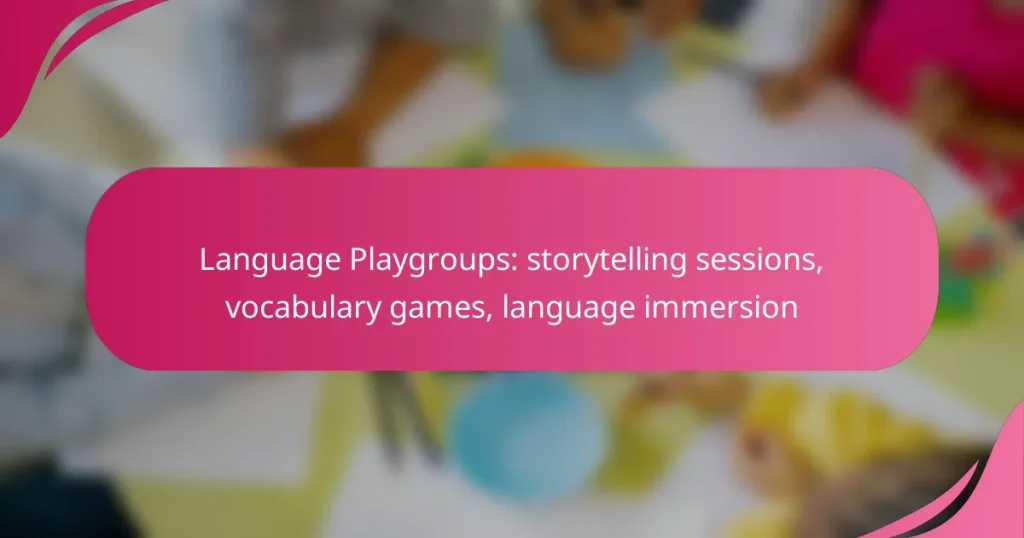Language playgroups offer a vibrant setting for children to enhance their storytelling abilities and vocabulary through interactive sessions. By engaging in storytelling and vocabulary games, children not only develop essential language skills but also foster creativity and collaboration with peers. Additionally, language immersion within these groups provides a natural context for children to acquire new languages, promoting deeper understanding and retention of vocabulary and grammar.
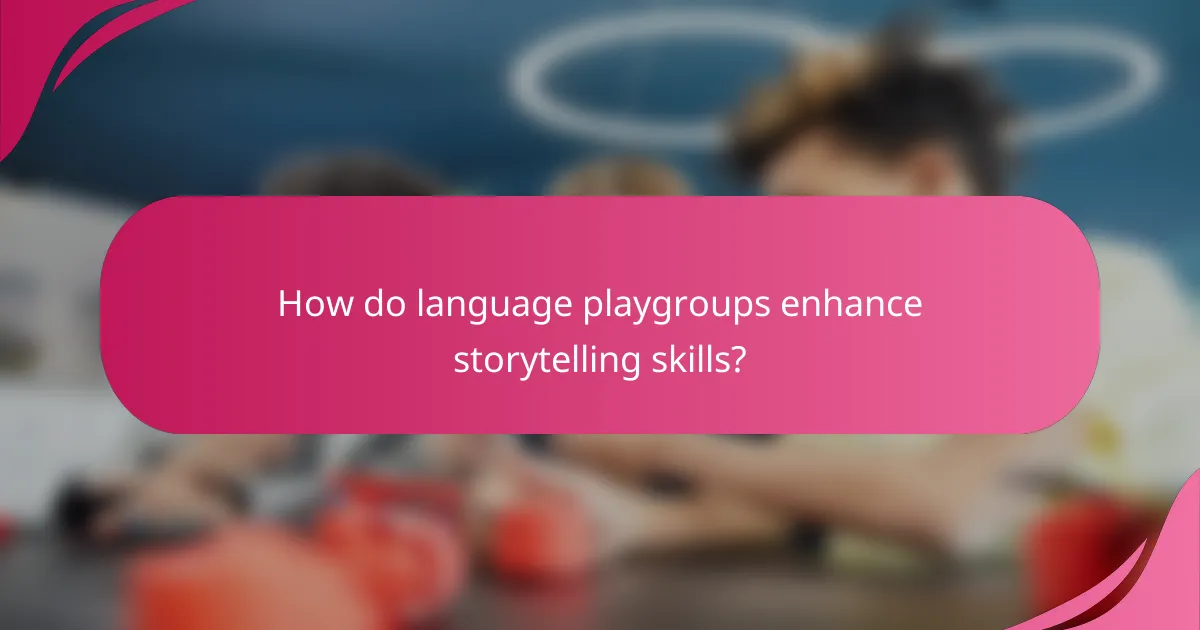
How do language playgroups enhance storytelling skills?
Language playgroups enhance storytelling skills by providing a dynamic environment where children can actively engage with narratives. Through interactive activities and peer collaboration, children develop vocabulary and comprehension while expressing their creativity.
Interactive storytelling sessions
Interactive storytelling sessions allow children to participate in the narrative process, making them active contributors rather than passive listeners. These sessions often involve prompts, questions, and opportunities for children to add their own ideas, which fosters creativity and critical thinking.
For example, a facilitator might start a story and then pause, inviting children to suggest what happens next. This not only boosts their storytelling skills but also enhances their ability to think on their feet and articulate their thoughts clearly.
Engagement through visual aids
Visual aids play a crucial role in language playgroups by helping children visualize the stories being told. Illustrations, puppets, and props can make narratives more engaging and relatable, aiding comprehension and retention of vocabulary.
Using visual aids, such as storyboards or picture books, can help children connect words with images, reinforcing their understanding of new vocabulary. This multisensory approach caters to different learning styles, making storytelling more accessible and enjoyable.
Peer collaboration in narratives
Peer collaboration in narratives encourages children to work together, sharing ideas and building on each other’s contributions. This teamwork not only enhances their storytelling skills but also fosters social interaction and communication.
During group activities, children can take turns narrating parts of a story or creating a collective tale, which helps them learn from one another. Such collaborative efforts can lead to richer stories and a deeper understanding of narrative structure, as they learn to listen, negotiate, and incorporate diverse perspectives.
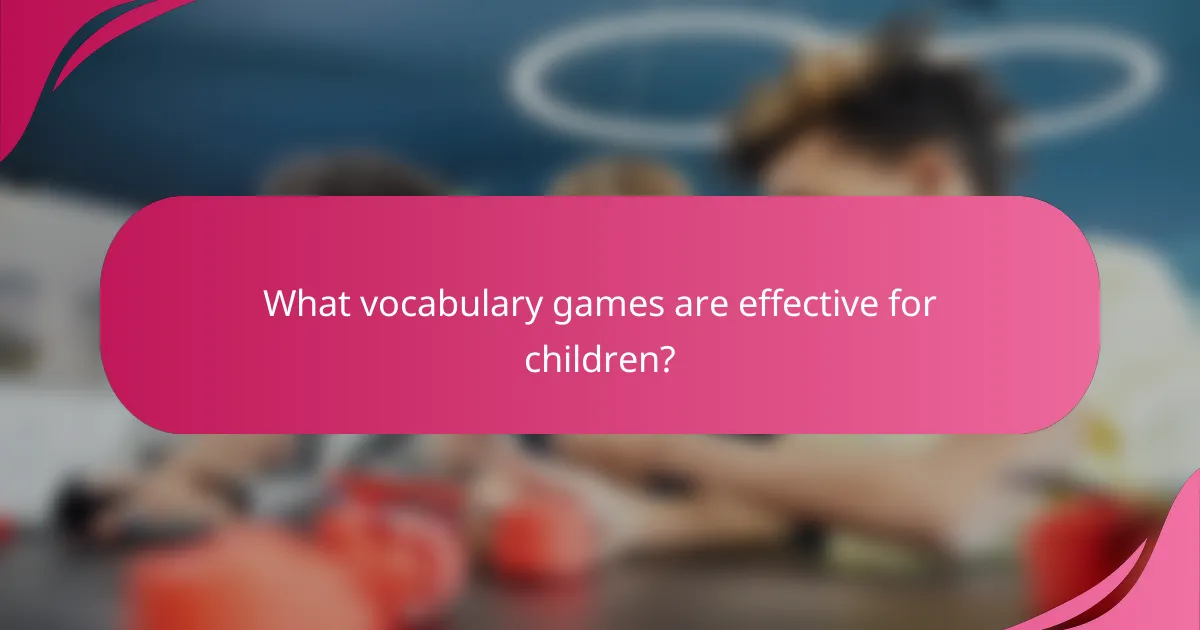
What vocabulary games are effective for children?
Effective vocabulary games for children are engaging activities that promote language development through play. These games help enhance word recognition, comprehension, and usage in a fun and interactive way.
Word association games
Word association games involve players saying words that are related to a given word. For example, if the starting word is “apple,” children might respond with “fruit,” “red,” or “pie.” This game encourages quick thinking and helps expand their vocabulary by connecting words and concepts.
To implement this game, gather a group of children and choose a starting word. Allow each child to take turns responding with associated words. Keep the pace lively to maintain engagement, and consider setting a timer for added excitement.
Vocabulary charades
Vocabulary charades is a physical game where children act out words or phrases without speaking, while others guess what they are. This game not only builds vocabulary but also enhances non-verbal communication skills. For instance, a child might mimic “swimming” by pretending to paddle in water.
To play, prepare a list of vocabulary words appropriate for the children’s age group. Write each word on a slip of paper and place them in a bowl. Players take turns drawing a word and acting it out, while their peers guess. Encourage creativity and use of gestures to make the game more dynamic.
Rhyming challenges
Rhyming challenges focus on identifying and creating words that rhyme with a given word. For example, if the word is “cat,” children might come up with “hat,” “bat,” or “mat.” This activity strengthens phonemic awareness and helps children understand sound patterns in language.
To conduct a rhyming challenge, start with a simple word and ask children to take turns saying rhyming words. You can increase the difficulty by introducing multi-syllable words or setting a time limit for responses. Consider rewarding creativity with small prizes to motivate participation.
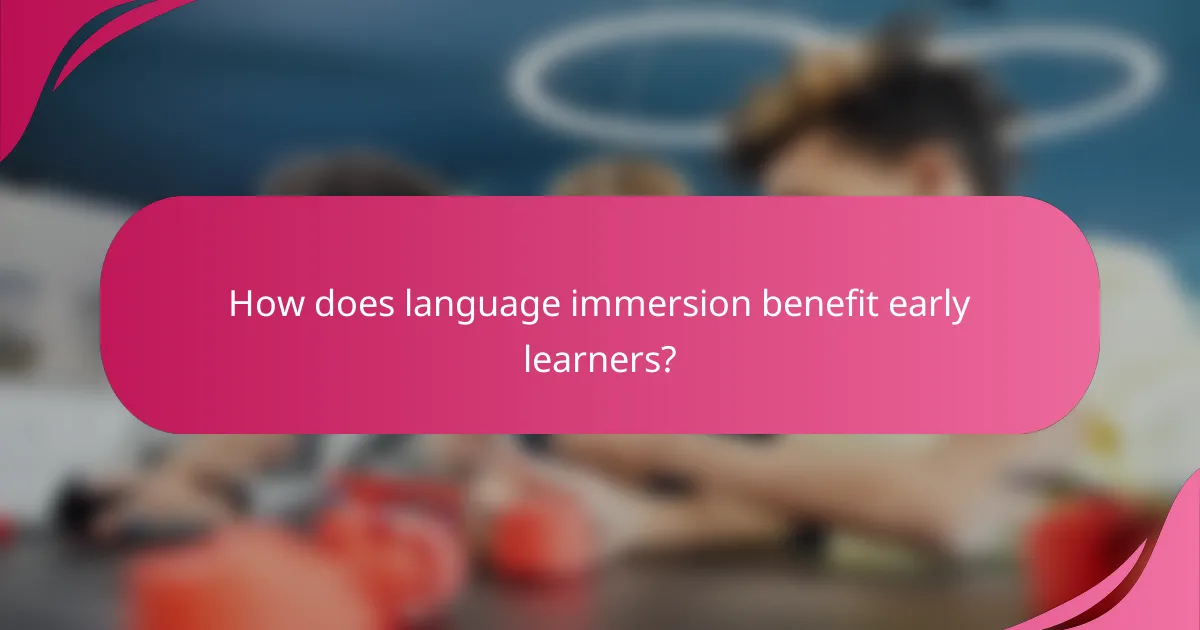
How does language immersion benefit early learners?
Language immersion significantly enhances early learners’ ability to acquire new languages by surrounding them with the target language in a natural context. This method fosters a deeper understanding and retention of vocabulary and grammar through consistent exposure and practice.
Increased fluency through practice
Regular engagement in language immersion activities helps children develop fluency by allowing them to practice speaking and listening in real-time. This consistent practice can lead to quicker mastery of pronunciation and conversational skills compared to traditional learning methods.
For example, participating in storytelling sessions where children narrate stories in the target language encourages spontaneous use of vocabulary. This active participation is crucial for building confidence and fluency.
Real-life language application
Language immersion provides opportunities for learners to apply their language skills in everyday situations, making the learning process more relevant and practical. By using the language in context, children can better understand its usage and nuances.
Activities like vocabulary games that incorporate real-life scenarios, such as shopping or dining, allow children to practice language skills they will use outside the classroom. This approach reinforces learning and helps solidify their understanding of the language.
Cultural exposure and understanding
Immersion in a language also exposes learners to the associated culture, enhancing their overall understanding and appreciation. This cultural context helps children grasp idiomatic expressions and social norms that are integral to effective communication.
Incorporating cultural elements, such as traditional stories or songs, into language playgroups can deepen children’s connection to the language. This exposure not only enriches their vocabulary but also fosters a sense of global awareness and empathy towards different cultures.
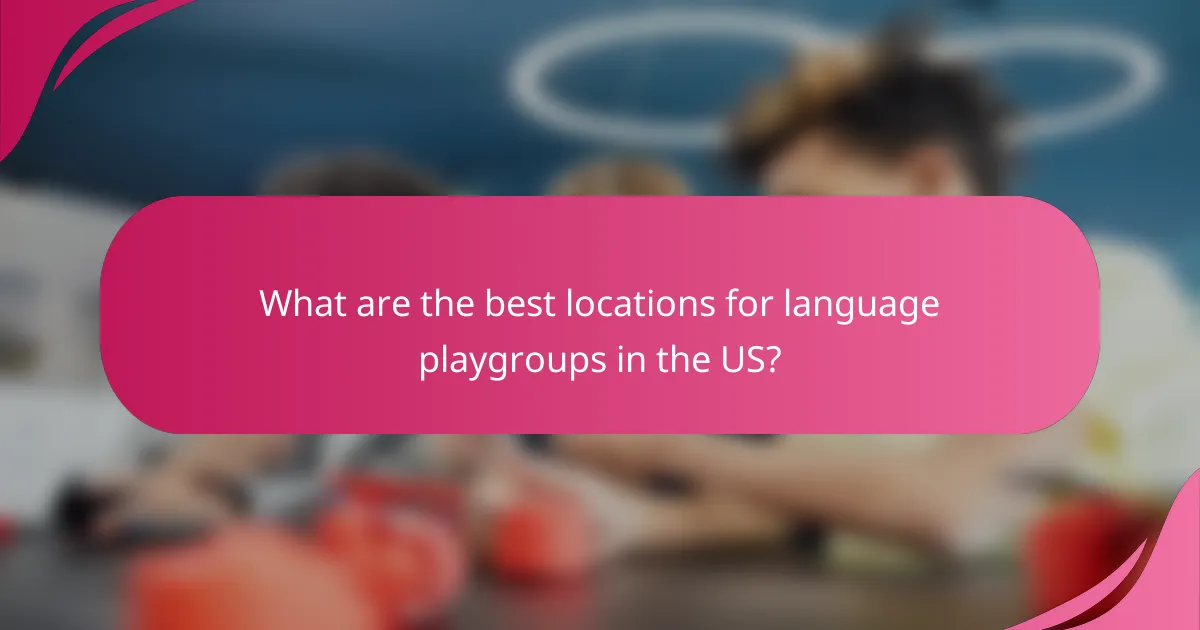
What are the best locations for language playgroups in the US?
The best locations for language playgroups in the US include community centers, libraries, and schools that offer engaging storytelling sessions, vocabulary games, and immersive language experiences. These venues often provide structured programs that cater to various age groups and language levels, making them ideal for fostering language development.
Community centers in New York
Community centers in New York City are excellent venues for language playgroups, offering a variety of programs tailored for children. Many centers host weekly sessions that include storytelling, interactive games, and cultural activities, often led by experienced educators or native speakers.
When selecting a community center, consider factors such as location, schedule flexibility, and the specific languages offered. Popular centers like the 92nd Street Y and the Brooklyn Public Library frequently have language immersion programs that can enhance vocabulary and comprehension skills.
Libraries in Los Angeles
Libraries in Los Angeles serve as valuable resources for language playgroups, providing free access to language learning materials and community programs. Many branches organize regular storytelling hours and language workshops that encourage participation through fun activities and games.
Check local library schedules for events like bilingual storytime or language clubs, which can be a great way to engage children in a supportive environment. The Los Angeles Public Library system often collaborates with local organizations to offer diverse language options.
Schools in Chicago
Schools in Chicago frequently host language playgroups as part of their extracurricular offerings, focusing on both language acquisition and cultural awareness. These programs often include storytelling sessions, vocabulary-building games, and group activities that promote language skills in an interactive setting.
Look for schools with strong language programs or partnerships with community organizations. Many public and private schools offer after-school language clubs that cater to various age groups, making it easier for parents to find suitable options for their children.

How to choose the right language playgroup?
Choosing the right language playgroup involves assessing various factors such as program structure, instructor qualifications, and group dynamics. These elements significantly influence the effectiveness of language learning and the overall experience for children.
Assessing program structure
The program structure should include a mix of storytelling sessions, vocabulary games, and immersive activities that engage children in the target language. Look for playgroups that offer a well-rounded curriculum, ideally incorporating both structured lessons and free playtime.
Consider the frequency and duration of sessions as well. Weekly meetings of 1-2 hours are common, but some programs may offer shorter, more frequent sessions. Ensure that the schedule aligns with your family’s availability and preferences.
Evaluating instructor qualifications
Instructors should have relevant qualifications, such as degrees in education or linguistics, and experience working with young children. Native speakers or those with advanced proficiency in the target language can provide authentic language exposure.
Ask about the instructors’ teaching methods and their ability to create a fun, engaging environment. Observing a session or asking for references can help gauge their effectiveness in facilitating language acquisition.
Considering group size and dynamics
The ideal group size typically ranges from 5 to 12 children, allowing for personalized attention while fostering social interaction. Smaller groups can enhance language practice, while larger groups may offer diverse peer interactions.
Pay attention to the age range and language levels of the children in the group. A mix of ages can promote peer learning, but ensure that the language level is appropriate for your child to avoid frustration or disengagement.

What are the costs associated with language playgroups?
The costs associated with language playgroups typically include monthly membership fees and one-time registration costs. Understanding these expenses can help parents budget effectively for their child’s language development activities.
Monthly membership fees
Monthly membership fees for language playgroups can vary widely based on location and the specific program. Generally, these fees range from around $30 to $100 per month, depending on the frequency of sessions and the resources provided.
When considering a playgroup, evaluate what is included in the membership. Some programs offer additional materials, access to online resources, or discounts for siblings, which can enhance the overall value.
One-time registration costs
One-time registration costs for language playgroups usually cover administrative expenses and initial materials. These fees typically range from $20 to $50, though some programs may charge more for specialized resources.
It’s advisable to check if the registration fee includes any starter kits or materials, as this can save additional costs later. Always inquire about refund policies in case your child cannot attend after registration.
